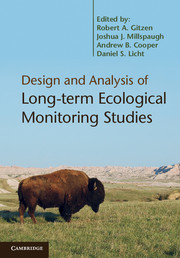Book contents
- Frontmatter
- Contents
- List of contributors
- Foreword: Ecology, management, and monitoring
- Preface
- Acknowledgments
- Abbreviations
- Section I Overview
- Section II Survey design
- Section III Data analysis
- 11 Analysis options for estimating status and trends in long-term monitoring
- 12 Analytical options for estimating ecological thresholds – statistical considerations
- 13 The treatment of missing data in long-term monitoring programs
- 14 Survey analysis in natural resource monitoring programs with a focus on cumulative distribution functions
- 15 Structural equation modeling and the analysis of long-term monitoring data
- Section IV Advanced issues and applications
- Section V Conclusion
- References
- Index
- Plate Section
12 - Analytical options for estimating ecological thresholds – statistical considerations
Published online by Cambridge University Press: 05 July 2012
- Frontmatter
- Contents
- List of contributors
- Foreword: Ecology, management, and monitoring
- Preface
- Acknowledgments
- Abbreviations
- Section I Overview
- Section II Survey design
- Section III Data analysis
- 11 Analysis options for estimating status and trends in long-term monitoring
- 12 Analytical options for estimating ecological thresholds – statistical considerations
- 13 The treatment of missing data in long-term monitoring programs
- 14 Survey analysis in natural resource monitoring programs with a focus on cumulative distribution functions
- 15 Structural equation modeling and the analysis of long-term monitoring data
- Section IV Advanced issues and applications
- Section V Conclusion
- References
- Index
- Plate Section
Summary
Introduction
The concept of ecological thresholds increasingly is attracting the attention of ecologists and managers of natural resources. As defined by Groffman et al. (2006), “an ecological threshold is the point at which there is an abrupt change in an ecosystem quality, property or phenomenon, or where small changes in an environmental driver produce large responses in the ecosystem.” Because of the complicated nonlinear dynamic of a threshold change and multiple factors that can affect the same ecosystem, detection and quantification of ecological thresholds is a challenging task.
Related to the threshold concept in ecology is the general category of changepoint models in statistics. This category encompasses a large collection of statistical models. For example, a recent review of the topic resulted in a 230-page annotated bibliography (Khodadadi and Asgharian 2008). The term “change point” has evolved in the past 50 years. In the 1950s, we find descriptions such as “a change in parameter occurring at an unknown time” (Page 1955) and “a linear regression system obeying two separate regimes” (Quandt 1958). More general terms such as “threshold regression” (Dagenais 1969), “segmented strait lines” (Bellman and Roth 1969), and “piecewise regression” (McGee and Carleton 1970), and more abstract terms such as “change point” [which probably first appeared in Hinkley (1970) and Hinkley and Hinkley (1970)] appeared in the late 1960s and early 1970s.
- Type
- Chapter
- Information
- Design and Analysis of Long-term Ecological Monitoring Studies , pp. 279 - 297Publisher: Cambridge University PressPrint publication year: 2012
- 1
- Cited by

